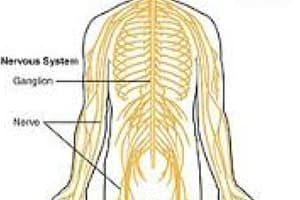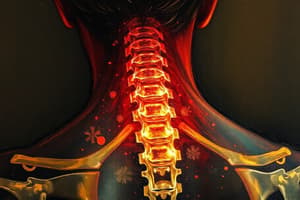Podcast
Questions and Answers
What additional diagnostic tool is recommended for major trauma victims to evaluate potential C-spine injuries?
What additional diagnostic tool is recommended for major trauma victims to evaluate potential C-spine injuries?
- Magnetic Resonance Imaging (MRI)
- X-ray of the thoracic spine
- Routine CT scans (correct)
- Ultrasound of the cervical spine
Which of the following statements about NEXUS criteria is true?
Which of the following statements about NEXUS criteria is true?
- Its reliability is affected by the presence of distracting injuries. (correct)
- It is always reliable for diagnosing C-spine injuries.
- It mandates radiographic evaluation for all injured patients.
- It does not require patient alertness for assessment.
What is one of the Canadian C-spine rule questions that eliminates the need for radiographic studies?
What is one of the Canadian C-spine rule questions that eliminates the need for radiographic studies?
- Can the patient rotate the neck laterally without pain? (correct)
- Does the patient show signs of intoxication?
- Is there tenderness in the lower back?
- Is the patient under the age of 5?
What clinical findings suggest a low probability of a C-spine injury in an injured patient?
What clinical findings suggest a low probability of a C-spine injury in an injured patient?
Under which circumstance are children considered free of C-spine injury?
Under which circumstance are children considered free of C-spine injury?
Which aspect of the Canadian C-spine rule is said to be more reliable than the NEXUS criteria?
Which aspect of the Canadian C-spine rule is said to be more reliable than the NEXUS criteria?
What does the absence of clinical findings suggest regarding C-spine injuries in pre-elementary schoolchildren?
What does the absence of clinical findings suggest regarding C-spine injuries in pre-elementary schoolchildren?
What is one limitation of the NEXUS criteria highlighted in the diagnosis of C-spine injuries?
What is one limitation of the NEXUS criteria highlighted in the diagnosis of C-spine injuries?
Flashcards
NEXUS criteria
NEXUS criteria
A set of clinical guidelines used to determine the likelihood of a cervical spine injury in patients with neck pain or suspected trauma.
Canadian C-spine rule
Canadian C-spine rule
This guideline focuses on three questions: 1. Are there high-risk factors requiring radiography? 2. Do low-risk factors allow safe neck range of motion evaluation? 3. Can the patient rotate their neck 45 degrees without pain? Answering 'no' to all three eliminates the need for radiography.
Absence of clinical findings
Absence of clinical findings
A key criterion for diagnosing C-spine injury, especially in the absence of neck pain, tenderness, or numbness in the upper extremities. It indicates a low probability of injury.
Distracting injury
Distracting injury
Signup and view all the flashcards
CT scan (Computed Tomography)
CT scan (Computed Tomography)
Signup and view all the flashcards
Unstable C-spine injury
Unstable C-spine injury
Signup and view all the flashcards
Posterior midline neck
Posterior midline neck
Signup and view all the flashcards
Focal neurological deficit
Focal neurological deficit
Signup and view all the flashcards
Study Notes
C-Spine Injury Diagnosis in Trauma Patients
-
NEXUS Criteria Limitations: The NEXUS criteria, while helpful for identifying low-risk patients for C-spine injury, frequently fail to detect clinically important unstable C-spine injuries in major trauma patients. A significant number of patients who initially passed NEXUS criteria were subsequently found to have serious C-spine injuries.
-
NEXUS Criteria: The NEXUS criteria are based on a clinical evaluation for patients without posterior midline neck tenderness, focal neurologic deficits,intoxication, and distracting injuries. A normal level of alertness is also required.
-
Difficulties with Distraction Injuries: A major contributing factor in the lower reliability of the NEXUS criteria is the difficulty of accurately identifying and assessing the severity of distracting injuries.
-
Canadian C-spine Rule: This rule aims to reduce unnecessary radiography by identifying low-risk patients.
-
Canadian C-spine Rule Criteria: The rule outlines three key questions to reduce C-spine radiography for low-risk patients.
- Are there high-risk factors requiring radiography?
- Are there low-risk factors allowing for safe neck range-of-motion assessment?
- Can the patient rotate their neck 45 degrees laterally without pain?
-
Canadian Rule vs. NEXUS: The Canadian C-spine rule is demonstrably more reliable than NEXUS in diagnosing C-spine injury in conscious patients.
-
Absence of Clinical Findings: Patients without neck pain, tenderness, or upper extremity paresthesia, especially if no distracting pain is present, are often considered at low risk for C-spine injury.
-
Pre-elementary Schoolchildren: Absence of clinical findings (symptoms), is also a strong indicator for pre-elementary school children. This eliminates the need for diagnostic studies (and radiation exposure).
-
Children with Persistent Midline Neck Pain: Children with sustained midline neck pain, in the absence of other symptoms, and negative initial imaging are also at very low risk for unstable C-spine injury.
Studying That Suits You
Use AI to generate personalized quizzes and flashcards to suit your learning preferences.




